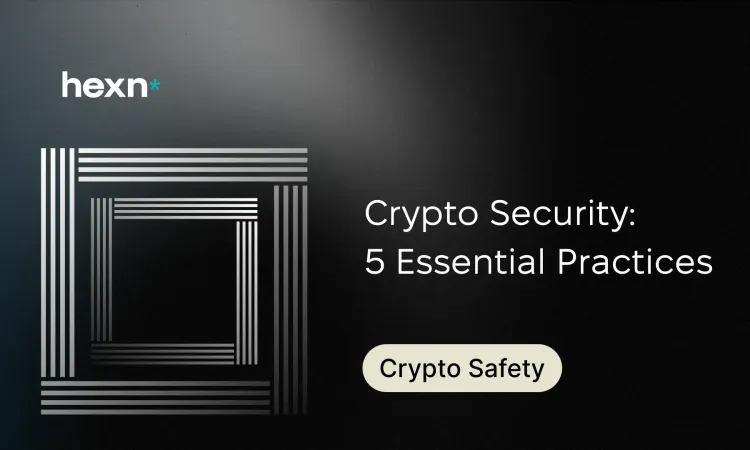Crypto Security: 5 Essential Practices
Cryptocurrency ownership brings new freedoms — and new responsibilities. Knowing how attackers operate and applying a few simple habits can dramatically reduce the risk of losing funds. This guide explains five practical security measures anyone holding crypto should use and why they matter.
Quick Security Checklist
- Keep your recovery/seed phrase offline and in a secure physical location.
- Verify social profiles before trusting messages or promotions from public figures.
- Avoid public WiFi when signing into wallets or sending transactions.
- Be skeptical of livestream giveaways — most require you to send funds first.
- Watch for AI deepfakes and other synthetic media that impersonate trusted voices.
Why Basic Security Hygiene Matters
Digital assets are attractive targets because transactions are irreversible and control is tied to secret keys. A single compromised credential or careless action can result in permanent loss. The tips below focus on reducing exposure to common attack vectors without requiring advanced technical skills.
1. Keep Your Seed Phrase Offline and Protected
Your seed phrase (also called a recovery phrase) is the master key to a wallet. Anyone who obtains it can move funds. Treat it like cash or a legal document.
Store the Phrase Offline
Don’t save your seed in cloud storage, email drafts, screenshots, or on devices that connect to the internet. Store it physically — for example, in a locked safe or bank deposit box — so it cannot be accessed remotely.
Prefer Durable Backups
Paper can degrade or be damaged in a fire. If possible, use a corrosion-resistant metal backup or an engraved plate to preserve your phrase long-term.
Consider Splitting the Phrase
For extra resilience, you can split the words into multiple parts and keep them in separate secure locations. That lowers the chance that a single theft or disaster will expose the entire phrase.
2. Recognize and Avoid Fake Social Media Accounts
Fraudsters often clone celebrity or company profiles to run scams and false promotions. Attackers may post offers that push you to authorize transactions or reveal private keys.
- Check the handle carefully: Slight spelling changes or extra characters are common in impersonations.
- Review account history: Genuine accounts usually have a consistent posting record; newly created or thin profiles are suspect.
- Don’t rely solely on badges: Verification marks can be misleading; use multiple signals to confirm authenticity.
3. Don’t Use Public WiFi for Wallet Access
Open networks are convenient but insecure. Attackers can intercept traffic, create fake hotspots, or use tools to capture credentials and private keys.
Common Threats on Public Networks
- Evil twin hotspots: Malicious networks named like a legitimate one to trick users into connecting.
- Man-in-the-middle attacks: Intercepted communication can expose sensitive data.
- Router or password cracking: Attackers may break into local devices to monitor or manipulate traffic.
If you must use public internet, use a personal mobile hotspot or a trusted VPN and avoid signing into wallets or approving transactions until you’re on a secure connection.
4. Be Careful with Giveaways and Risky Promotions
Scammers repurpose legitimate video clips and hijack channels to promote fake crypto giveaways. These scams usually instruct viewers to send funds first to receive more back — a one-way ticket to loss.
- Verify the channel: Look at the account creation date, the volume of past content, and whether the channel’s distribution patterns are consistent with the claimed owner.
- Cross-check announcements: Legitimate promotions are typically announced across multiple verified official channels—not just a single stream.
- Never send funds to participate: Genuine giveaways don’t require upfront transfers to you as a condition to receive something.
5. Stay Aware of AI Deepfakes
AI tools can create convincing audio and video that make a person appear to say or do things they never did. Attackers use this to pressure victims with fake endorsements, urgent calls, or fabricated proof.
- Watch for visual glitches: Unnatural blinking, inconsistent lighting, or odd facial movements can indicate manipulation.
- Listen for audio oddities: Robotic tones, mismatched lip-sync, or strange cadence are red flags.
- Ask verification questions: If contacted by someone claiming to be a known person, request details only the real person could confirm or validate the message through separate, trusted channels.
Steps You Can Apply Today
- Move your seed phrase off any internet-connected device and store a durable physical backup.
- When you see crypto offers on social media, pause and validate the account and announcement before interacting.
- Use secure networks or personal hotspots when accessing wallets; avoid open WiFi for transactions.
- Ignore livestreams asking for upfront funds and confirm promotions via multiple trusted sources.
- Keep a critical eye on unexpected media; verify identity claims before trusting urgent requests.
Security is an ongoing practice, not a one-time task. Attackers adapt, so combine simple habits — careful storage, skepticism online, and safe network use — to keep your crypto holdings better protected.
